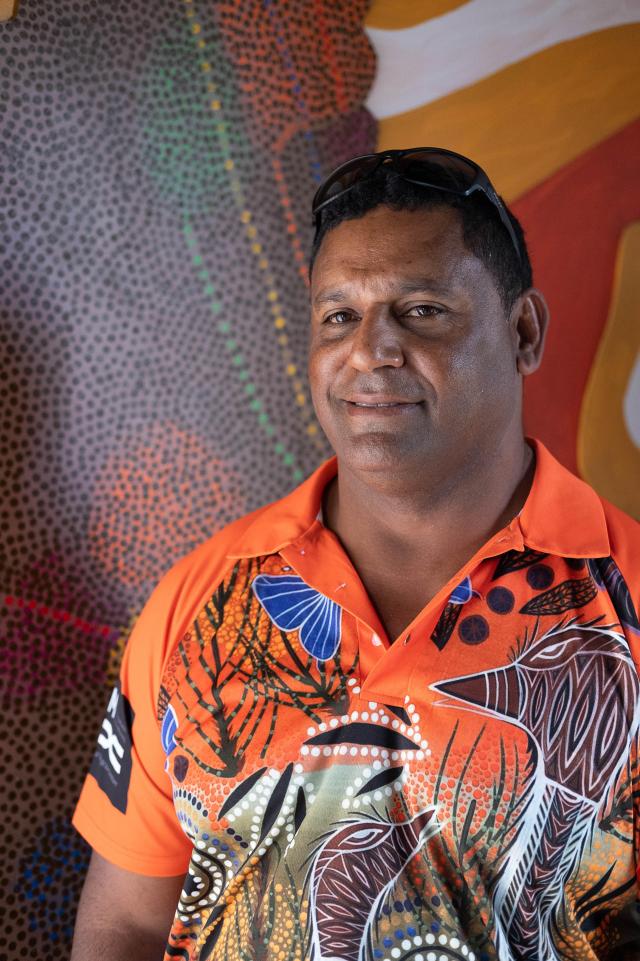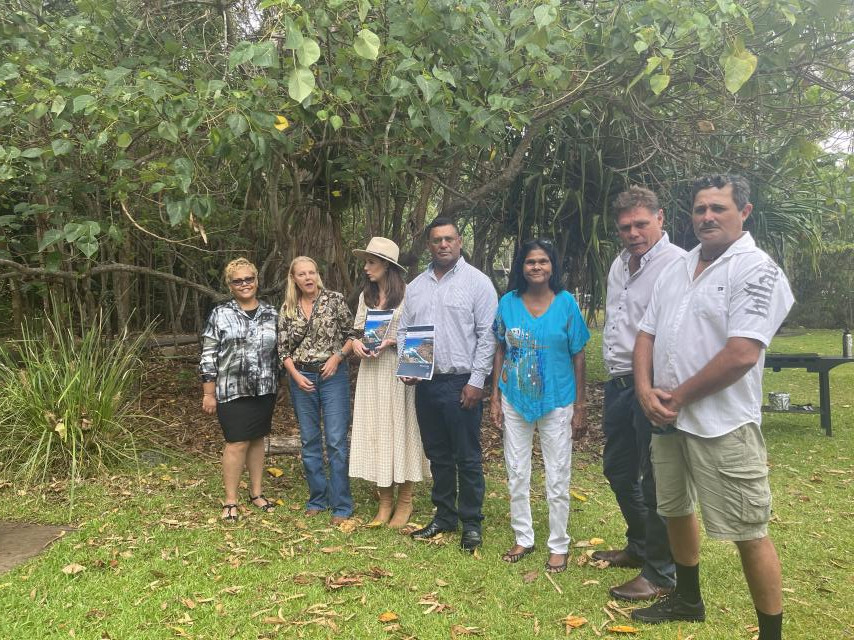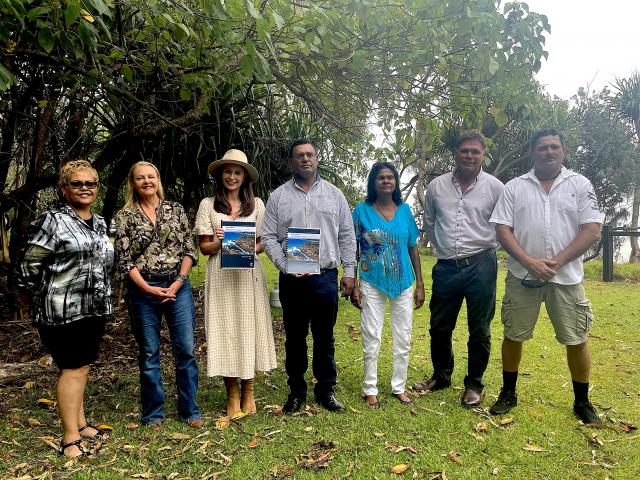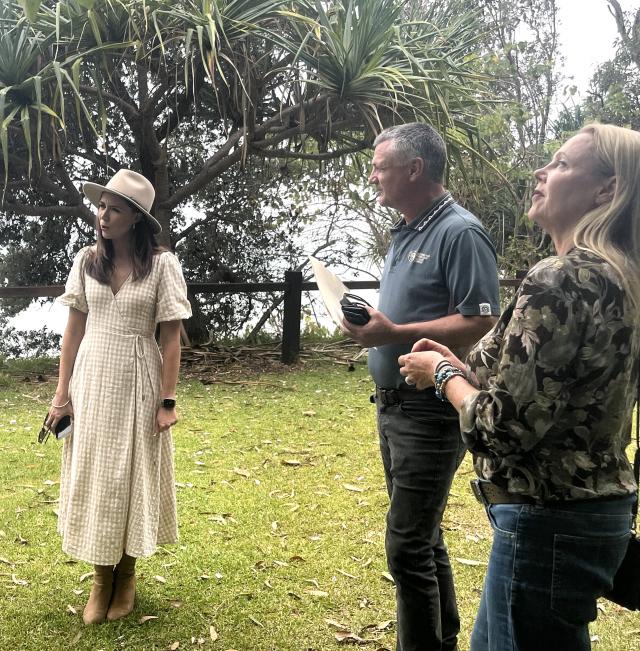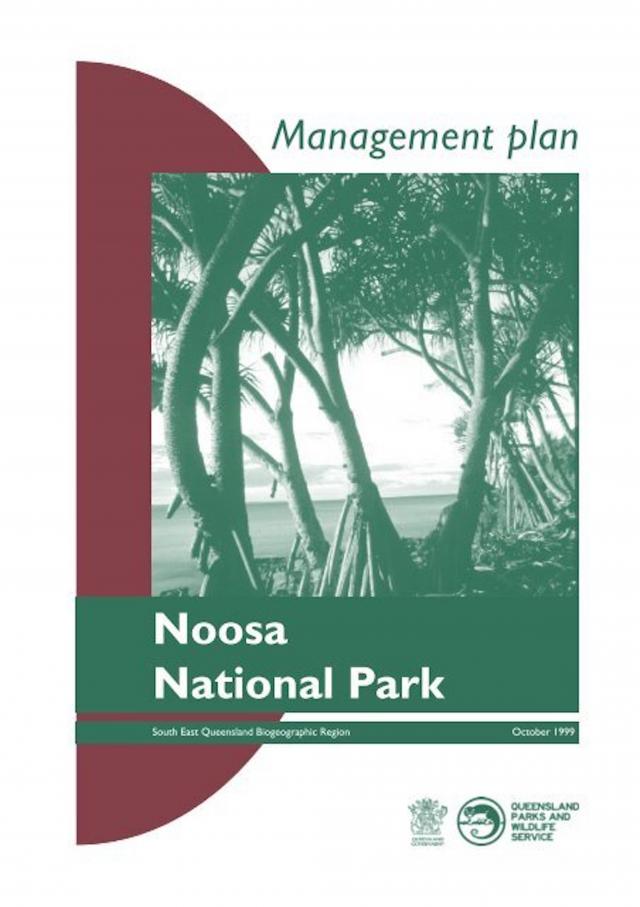On a drizzly, steamy day in Noosa National Park last week, Norman Bond, the chairman of the Kabi Kabi Peoples Aboriginal Corporation, seated next to Environment Minister Meaghan Scanlon at a long and rickety camp table on the lawn beside Laguna Bay, cast his eye around the gathering and said: “I grew up in Cherbourg and never thought we’d have opportunities like this.”
This would be the first of several mentions by the five members of the Kabi Kabi Native Title claimant group present of the unlikelihood of this, a seat at the table. However humble and informal the occasion may have been, it symbolised, not only for the Kabi Kabi, but for everyone there, the new way we manage national parks in Queensland. Not in consultation, but in partnership.
The occasion was the launch of the Noosa Area Management Plan 2022, a 31-page document that sets the management agenda for the next decade for the five parks in Noosa Shire under the jurisdiction of the Queensland Parks and Wildlife Service, including the iconic headland section of Noosa National Park. And it is the clearest documentation yet of how Native Title will and should work in practical ways now and into the future.
As Ms Scanlon noted on social media: “Today we officially launched the new Noosa Area Management Plan, setting out the key values and management priorities of the park with the Kabi Kabi traditional owners.”
Plan 2022 doesn’t beat around the bush, so to speak. On its first page it declares: “This management plan has been prepared and co-designed by the Kabi Kabi People and Queensland Parks and Wildlife Service (QPWS), Department of Environment and Science.
“The Department… recognises, respects and values First Nations peoples and cultures. “We recognise First Nations rights and interests in the Country on which we walk, work and live. We are committed to progressing self-determination by working in genuine partnerships with First Nations peoples to incorporate their priorities and perspectives across our decision-making and operations. The Gurra Gurra Framework 2020–2026 prioritises and accelerates this commitment, guiding the agency to embed Country and people at the centre of all that we do.”
Sound and fury signifying nothing?
Well, no, as evidenced by the people sitting around the table in the park, and the fact that behind the scenes Kabi Kabi people have been active in park management for quite some time, particularly elder Kerry Jones, who has worked with QPWS the length and breadth of the Sunshine Coast, helping to incorporate traditional ways of caring for country, including cultural burning.
This may have been a low-key “coming out” for the Kabi Kabi as park managers, but the Noosa Area Management Plan details on every other page the real ways in which this partnership will work. And it’s a far cry from what came before.
Although it appears to have been revised and updated several times in the intervening years, the last full “Noosa National Park Management Plan” was published more than 23 years ago, in October 1999. This was post-Mabo decision, Native Title Act and Keating’s Redfern Address, but only just. It treads lightly over mostly uncharted territory.
Under the Conservation heading, the 49-page plan notes that “sites of social significance will be managed in consultation with local community including Aboriginal groups”.
Under Management Obligations it notes: “Native Title claimants must be notified of the plan and, where possible, the undertaking of any prescribed burning”.
The 1999 plan contains a lot of “consulting” and “notification” but no mention of any partnership with Kabi Kabi, although under the heading of Cultural Heritage Management, it does offer a hint of a shared future: “A cultural heritage management plan will be developed and will identify Undumbi rights [the original land rights claim was on behalf of Undumbi/Kabi Kabi] in park management. Desired outcome – the interests of Aboriginal people are reflected through their involvement in the management of the park.”
Almost quarter of a century later, we can tick that box, proof positive that while First Nations business doesn’t always move fast, it does move. And while its launch seemed to have been designed so as not to frighten the horses, the management plan itself puts the realisation of an equitable partnership in the full glare of the spotlight on nearly every page.
Meanwhile, back at the table in the park, Norman Bond, the dignified and eloquent Kabi Kabi chairman, said: “This is the way forward for Kabi Kabi. Hopefully the relationships and the partnership we’re building with QPWS will be nurtured well into the future, because the work we do collaboratively is very important. We learn more as we go along, but the journey has to continue, and the values-based framework [of QPWS management] makes sense to us, that’s how we achieve our long-term goals.
“Things like traditional burning take time, we understand that, but I always look forward to sitting down and talking to QPWS about these issues, because our leaders in the past didn’t have these opportunities. I feel very optimistic for the future of Kabi Kabi people because of that. We’re not operational in some aspects of land management yet, but we will get there, and our aim is to become established in many areas and train our people up. The opportunity is there for us to work with QPWS and with other stakeholders.”
Kerry Jones agreed: “A lot of our country has changed. When they took the old people away it didn’t take long for the land to be managed inappropriately, so if we can teach the young ones to bring back the old ways it will help a lot. But we all learn off each other, that’s the way forward, and it’s how we can tackle noxious weeds without using herbicides.
“It’s an ongoing process and I think there’s a lot of employment opportunity for our people in land management, but it can’t be a six-month program, it’s got to be ongoing.”
Norman Bond: “The opportunities for us are everywhere today, and we have government that supports that change. I’m grateful for that, and I’m sure the majority of Kabi Kabi people think the same way.”
Among the goodwill that flowed around the table, along with sausage sandwiches and cold water on a hot day, Kabi Kabi Corporation secretary Brian Warner sounded a note of caution: “It’s about self-determination, and this document [Plan 2022] is an example of that, but we don’t have certainty of that if there’s a change in government because it’s not in the constitution. Right now we have surety in our relationship with QPWS but only through a political party, and if that changes all this collaborative work could disappear or go backwards.”
QPWS spokesperson Anthony Ross was reassuring: “I take on board what Brian is saying about certainty and change of government, but I believe we are building partnerships and a trust here that are unstoppable, and will be resilient to any changes.”
No doubt the proof will be in the pudding, with the rollout of the Cooloola Great Walk project expected to be the next project of the Kabi/QPWS partnership, and be ongoing well beyond the life of the current state government.
At the meeting in the park, Noosa MP Sandy Bolton was praised by Minister Scanlon for being “an incredible advocate” for the Kabi Kabi partnership.
Sandy later told Noosa Today:
“This was a new kind of meeting for me and I think it was fantastic to have an open conversation and also to feel the genuine excitement from Kabi, and their positive hope. “But also, their realistic viewpoints about the present and the future. We often speak about Kabi coming home 100 years after being moved to Cherbourg, but I loved hearing the little things from [Kabi director] Cecilia Combo about bringing family back and what it meant to them. I was also thrilled to learn that the relationship between Kabi and government is moving beyond politics.
“It means continuity no matter who is elected, and what I saw at the meeting was that the relationship between Kabi Kabi and QPWS is in the very best interests of our national parks. Norman said he never thought he’d see it in his lifetime. That made me feel very proud to have been a small part of it.
“I think the Noosa Area Management Plan is a first for Noosa in that it outlines the partnership between Kabi and QPWS in a way that has never been done before. There has never been such extensive collaboration.”
As I left the meeting another participant pulled me aside and said: “You know what this is, don’t you? It’s an example of the Voice at a local level, of Kabi Kabi having the opportunity to talk with decision-makers about what should happen. It’s also an example of making agreements and partnerships at a local level. In that way it starts to mirror the national conversation.”
I reflected on that remark several days later when I watched Professor Megan Davis, a co-author of the Uluru Statement From The Heart, repeatedly describe on ABC television the Voice in practice being a “seat at the table” for even the smallest First Nations communities.
I thought, wouldn’t it be wonderful, given our lamentable early history with Kabi, if Noosa could now play a pioneering role in that process.
See the full management plan here: parks.des.qld.gov.au/__data/assets/pdf_file/0035/288485/noosa-area-management-plan.pdf

